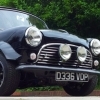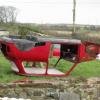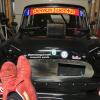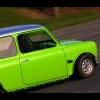Rear Hub Nut Torque Settings
#1

Posted 13 May 2012 - 11:10 AM
I'm replacing the rear wheel bearings on my 86 Mayfair, I've upgraded the roller bearings to these Timken rear tapered roller bearings: http://www.minispare...id=38270&title=
I've found the torque settings in a few manuals to be 60lb/ft but I think that figure is for the roller bearings, does anyone know what settings to use for the tapered ones?
Quick replies appreciated!
#2

Posted 13 May 2012 - 01:49 PM
With regard to wheel bearing torque, the Mini is different from every other car I have worked on. In most other cars with taper roller bearings, the instructions would be to torque to a certain value, spin the wheel by hand, then loosen the nut by some number of degrees (like 1/4 turn) and fit the split pin. With those bearings the torque established a preload on the bearings... not so with a Mini.
#3

Posted 13 May 2012 - 02:42 PM
I spoke to a few people and am going for the following method, of tightening the nut hand tight with a socket, and then giving it another 1/4 of a turn and over to wherever the next split pin hole is. I've tried this way and it removes the play from the bearing, but still allows it to spin smoothly with hand pressure on the hub.
I've seen this method being recommended on TMF before too.
#4

Posted 13 May 2012 - 02:45 PM
#5

Posted 06 November 2021 - 04:53 PM
Hope I can start this thread again, need some help.
I'm rebuilding a 1981 saloon mini, the rear bearings were ok when I took the hubs off last year one side is bearings and the other is needle roller (that's how it came?). I can torque 81NM for the bearings and 83NM for the rollers no problem and I can line up the hole for the split pin, with the bearings side, but it is about 1mm from the top of the castle nut, the hole misses the top of nut completely on the needle bearing side. Both wheels spin freely when torqued.
Is is acceptable to fit a washer between the thrust washer and castle nut?
#6

Posted 06 November 2021 - 05:24 PM
The torque is the same for either bearing type. Why would you need to add a second washer?
#7

Posted 06 November 2021 - 07:12 PM
You'll torque them up to the figure in the book - which I always knew to be the same whether Ball Bearings or Tapered Rollers (60 ft / lb - sorry, I don't know off hand what the metric number is), then continue tightening the nut until you get the next hole and slot to align for the split pin. In case you weren't aware, as well as the 6 slots (3 in reality) there's also 2 holes through the stub for the pin, so that next bit of tightening shouldn't need a huge movement.
#8

Posted 07 November 2021 - 09:20 AM
The torque is the same for either bearing type. Why would you need to add a second washer?
I think the problem from the recent post is that the bearing seems to be thinner for some reason and hence when they go to put the split pin through the nut it either just engages one side of misses completely on the other.
In theory you could add another washer to over come this but before doing that I would want to understand why its different by comparing it to a good one, it might not matter but it could be the bearing is wrong or somehting has happened to the hub which needs further checking.
#9

Posted 07 November 2021 - 09:33 AM
The torque is the same for either bearing type. Why would you need to add a second washer?
I think the problem from the recent post is that the bearing seems to be thinner for some reason and hence when they go to put the split pin through the nut it either just engages one side of misses completely on the other.
In theory you could add another washer to over come this but before doing that I would want to understand why its different by comparing it to a good one, it might not matter but it could be the bearing is wrong or somehting has happened to the hub which needs further checking.
Sure thinner. Incorrectly assemble. Worn out. Or even the C clip has failed. A washer should not be needed. But there is no reason not to add one if wanted but if you have to I would be wanting to understand why.
#10

Posted 07 November 2021 - 06:02 PM
Many thanks for your reply's. As I'm not sure where the bearings came from i've decided to change both and hopefully that will fix it. I checked my old Haynes book and there is a typo. 60LB is converted to 81NM on one line and 83NM on another so 60Lb or 81NM for both ball and needle bearing.
#11

Posted 07 November 2021 - 07:30 PM
I have seen different thicknesses of castle nuts - are you using a new one by chance?
#12

Posted 08 November 2021 - 10:16 AM
No I don't think so it should still be the original. I have replaced the thrust washers and they appear a little thinner. There is a big difference in price between Timken GHK1805 and GHK1548ms at mini spares. Anyone know the difference? is it worth the extra £30+ per side?
#13

Posted 08 November 2021 - 11:53 AM
It is simple as one is Timken, one isn't.
(other than the extra o-ring, which is only pennies).
Of course, only one is in stock
Edited by GraemeC, 08 November 2021 - 11:54 AM.
#14

Posted 10 November 2021 - 12:33 PM
Graeme
Are you saying that the Timkens arn't worth the extra money? I have seen that they are made in China now.
I've stripped mine out again and it's a Timken and made in England. Its all OK so I've put it back on but needed a 2mm washer to ensure the castle nut and split pin fitted correctly.
#15

Posted 10 November 2021 - 06:20 PM
Are they worth the extra - I would say yes, definitely but others would argue.
It comes down to previous experiences and I’ve had bad experience with non-genuine bearings and will now only pay to have the branded ones.
Others have fitted the cheaper ones and had no problem, so they say the Timkens are not worth the extra.
Pays your money, takes your choice!
1 user(s) are reading this topic
0 members, 1 guests, 0 anonymous users



















